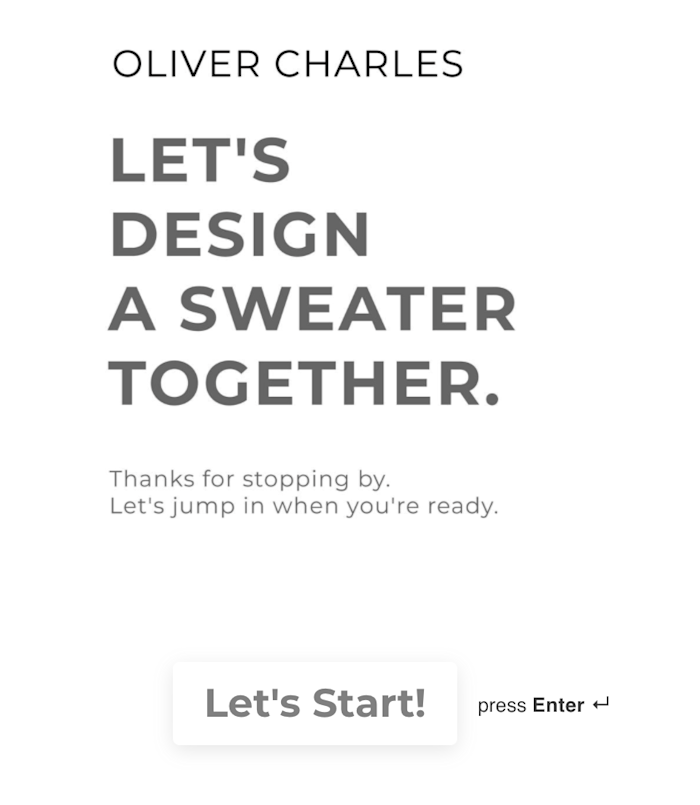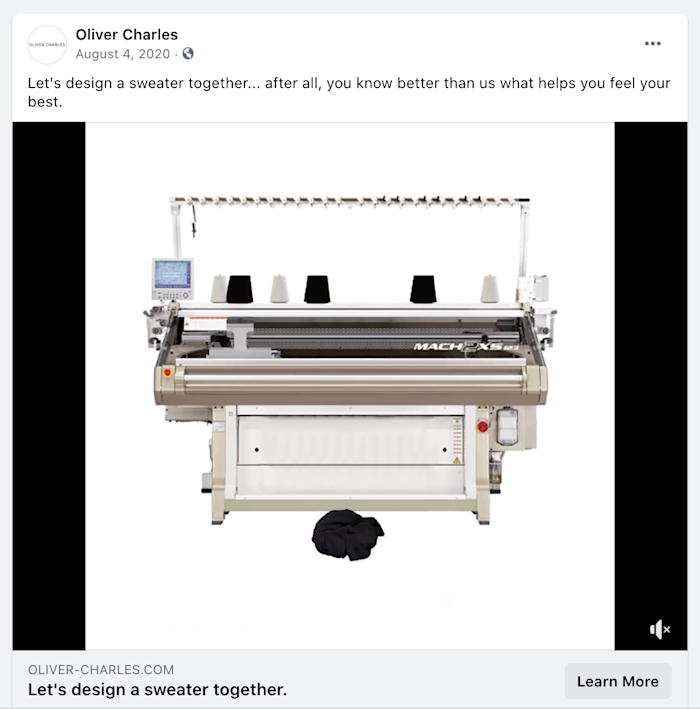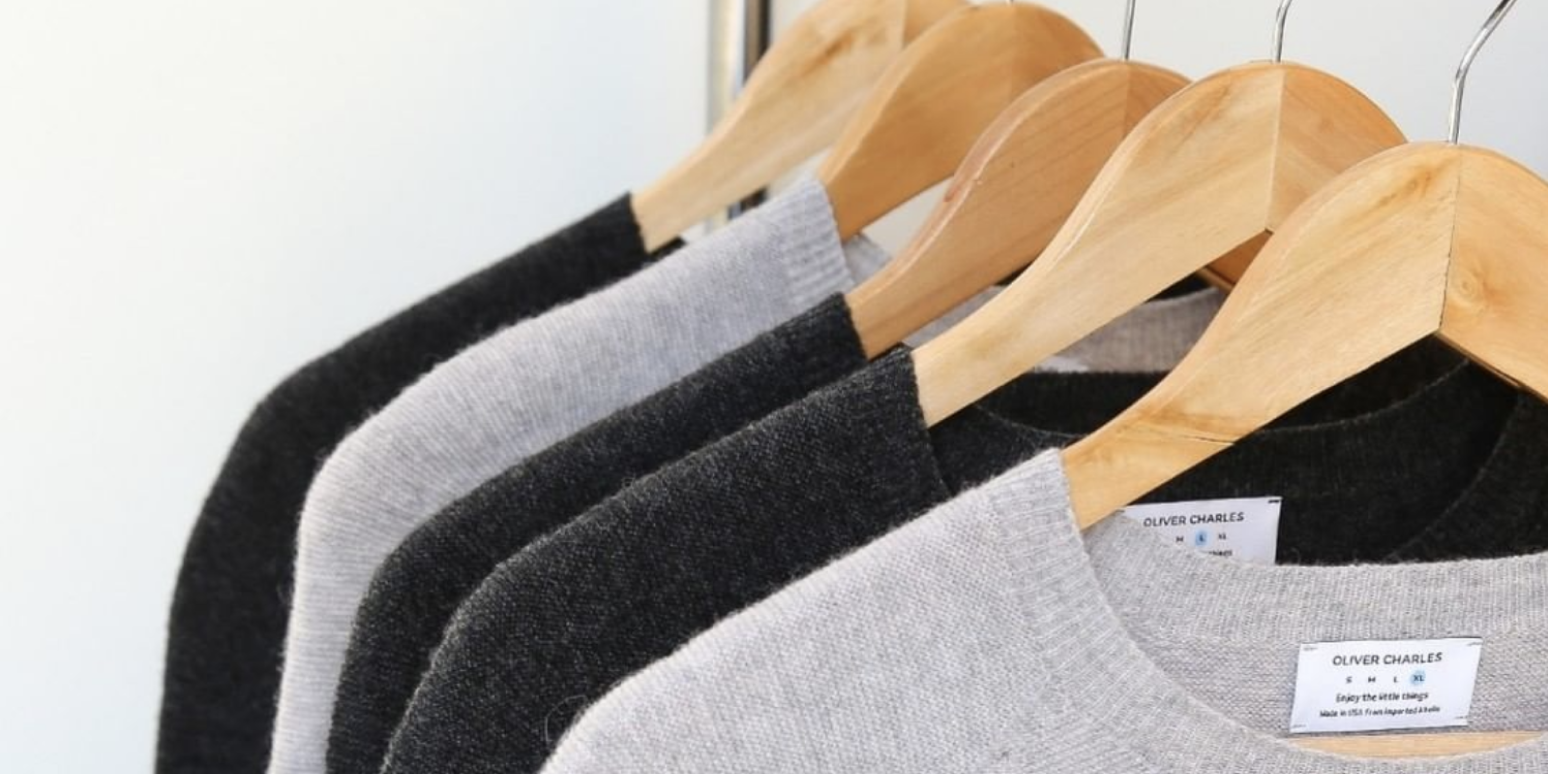When we first started Oliver Charles, we had zero experience in fashion. Neither my co-founder nor I had gone to design school, we’d never worked in fashion, and to be perfectly honest, we weren’t that fashionable. So when it came time to design our first product, a crew neck sweater, we decided the best path forward was to ask other people what they wanted.
The next day, we added a page to our website that said: “Help us design the perfect sweater.”
And that’s how our customer advisory board was born.
What is a customer advisory board?
When you’re developing something from scratch, whether it’s a new business, a new product, or even a new feature, there’s a chicken and egg sort of moment. What comes first: the product or the user? How do you get users without a product, and how do you know the product is worth developing without users?
That’s where a customer advisory board comes in handy. Simply put, it’s a way to get people interested in your product before it exists while also validating its existence. A good customer advisory board is one part community and one part feedback loop.
So how does it work? That depends. In our case, it was a series of activities ranging from taking surveys to getting things in the mail to testing the first versions of our product. A different fashion business, Betabrand, created a full-blown platform where customers can communicate with each other, share ideas, and give feedback on future products.
I’m a firm believer that any company, big or small, can benefit from a customer advisory board—it’s just a matter of designing one that fits your needs.
Know your goals
Start by asking why you need a customer advisory board. Are you trying to create a community? Do you need product testers? Are you trying to build an email list? Whatever it is, figure out what you want before communicating with potential members.
At Oliver Charles, we had the following goals (in order of importance).
-
Learn what kind of sweater people wanted
-
Develop a relationship with our customers and create superfans
-
Build an email list ahead of our crowdfunding campaign
-
Get user-generated content and social proof
-
Create a mechanism for viral growth
Your goals can—and should—change over time, depending on where you are with your business. For example, in the beginning, it was more important for us to engage with customers on a personal level. Then, once we got our prototypes, our focus shifted to user-generated content.
Know your value
To get people on board (literally), you need to figure out why they should care. How will they benefit from being a member? Don’t limit yourself here—it can be any number of reasons, both tangible and intangible.
For example, we promised members of our customer advisory board exclusive discounts and early access. The discount is a tangible benefit; the exclusivity is intangible. On top of that, our messaging centered around the fact that they’d be helping design a product they’d actually want. This encouraged members to continue to engage with us as we worked toward the same goal: designing the perfect sweater.
Here are a few reasons people might join a customer advisory board, but make sure to think specific to your business as well:
-
Discounts
-
Free products
-
Early access
-
Exclusive content
-
Co-marketing
Create a system
How people apply to join your board will depend on your goals. For example, if your main goal is email capture, then you want to lower the barrier to entry so you can get a lot of people interested. If your main goal is creating superfans, then raising that barrier to entry might make more sense. For Oliver Charles, a nine-question, mostly multiple-choice survey was a nice middle ground: just enough friction to attract folks who were committed to helping us but not enough to scare them away.

Pro tip: if you go the survey route, include questions on your survey that you want to know the answer to. Since the application is the first step, it’ll have the highest engagement rate, so it’s a great way to gather info even from people who drop off later on in the process. For example, if you’re looking for user-generated content, make sure you ask for people’s social handles so you can get a sense of the kind of content they produce. Our questions were designed to help us understand what kind of sweater people wanted.
You also need to figure out what happens when someone indicates their interest. In our case, when someone submitted the form, Zapier automatically added them to our Klaviyo account, which triggered an email drip campaign that walked new board members through the various activities we had planned.
Zapier lets you automatically send information from one app to another, helping you reduce manual tasks. Learn more about how Zapier works.
But there are other ways you could do it.
-
You could set up a Facebook Group and communicate with members there.
-
You could start a channel on Slack or Discord.
-
You could launch your own subreddit (like Pistol Lake did).
Whatever route you go, automate the process so you’re not manually adding new applicants to your other apps.
Find the right people
The next step, and arguably the most challenging, is finding people to join. We had a pop-up on our website, but since driving traffic to your website is a massive undertaking, we also tried a couple other things.
Facebook ads
We spent about $25/day on Facebook ads that drove people to a landing page with a link to the application. Very straightforward. In the end, it cost us a little over $4/member. And when we launched, advisory board members ended up being worth about $6/member—so it worked.
Here’s an example of the ad we ran during the campaign.

Referrals
While we were running our Facebook ads, we also did some referral campaigns. You could either tag a friend on one of our Instagram posts or give us an email address, and we’d reward you with an invitation to our 1-week challenge, during which you could get a free sweater (more on that later).
Tagging a friend on Instagram worked much better for us than collecting email addresses. People were more likely to do it, and those that got tagged were more likely to join.

Engage your board
Once you have a solid number of board members, you need to keep them engaged in order to reach the goals you set out at the beginning. We broke it down into five stages.
Stage 1: Introductions
We started by explaining what was to come and setting the tone for communication. The first email had two calls to action. The first prompted them to follow us on social media, and the second prompted them to unsubscribe, or as we called it, resign. Rather than hide the unsubscribe button, we made it big. We wanted to weed out people who weren’t interested and really put our messaging to the test.

Stage 2: Product input and data collection
Next, we started getting members involved in the design process. We accomplished this through three pretty extensive surveys. We wanted people to feel like they were making an impact, and we wanted as much data as possible. We delivered each survey via email one or two days apart.
Survey #1: Demographics
The first survey was about the individual. Our goal was to build an archetype of our customers. So we asked about the types of brands they liked, what they did for fun, whether or not they lived in a city, and so on. Ultimately, we used many of the data points collected here to craft copy and create audiences in Facebook. You can take the survey yourself here.

Survey #2: Product information
In the second survey, we asked questions specifically about sweaters to understand people’s preferences. We asked about their favorite sweater, styles, fit, and more. Most importantly for us, we asked them about color preference—using only the colors we could actually make.
That’s how we decided on the first two colors we produced, and we still use this data to decide which colors to launch next. You can take the survey yourself here.

Survey #3: Brand information
From the beginning, we knew we wanted to build something for the modern professional. So in the final survey, we asked folks about their work lives, what they did after work, how they dressed for work, their work-life balance, and so on. We also asked them what other brands they admired, and to this day, we keep a close eye on the brands people mentioned. You can take the survey yourself here.

In the end, about 30% of advisory board members completed all three surveys. This worked pretty well for us, but there are plenty of other ways you could engage your advisory board:
-
Run discussion forums
-
Have people contribute to a collective Pinterest board
-
Ask people to vote on something each day
-
Host live roundtables or Q&As
The bottom line is that you need people to feel like they are making an impact while collecting relevant data.
Stage 3: Validate and reward
We wanted to show that the work folks did filling out the surveys was not for nothing. So we did our best to showcase the aspects of the product and brand that were directly impacted by the data we collected. For example, whenever we could, we highlighted the fact that our board members chose the colors.
We also wanted to say thank you, so we sent all our board members a handwritten note, a sample of our materials, and a measuring tape. This demonstrated our appreciation and also gave them something to talk about with friends and family. (Not incidentally, this is when we asked them for referrals.)

Stage 4: Personal connection
Next, we wanted to identify the most engaged members, so we asked people to get on a video call with us and chat for 20 minutes. There’s nothing more valuable than speaking with customers about what they like and don’t like about the product you’re developing. Plus, when someone has an opportunity to chat with the founder of a brand, not only do they become customers for life, but they also become superfans.
At the end of each call, we’d invite the member to join our 1-week challenge, where they could get a free sweater—we wanted to reward those who were most committed to supporting us.
Stage 5: The 1-week challenge and UGC
The 1-week challenge was a challenge for our highly engaged members to wear our sweater for a week straight. The goal was to get people to rethink how they buy and wear clothing—and to get feedback on our prototype. Each participant paid a deposit equal to the price of a sweater ($200). They were then asked to wear it for seven days straight, take a picture each day, and submit a video testimonial. If they did all that, we refunded them the $200.

The 1-week challenge was the single most important aspect of our customer advisory board. We got valuable feedback on the sweater and received hundreds of authentic photos and videos of people enjoying the sweater, not to mention all the positive reviews.
Get people to buy
Once we officially launched, it was time to see how much our customer advisory board liked our stuff. The results? The board converted at around 4% and had a higher average order value (they bought more sweaters on average than non-members). When you pair that with the content and data we received, it was one of the best investments we made as a company.
Now that we’ve launched, we still run a customer advisory board—it’s just simplified. Rather than collecting data in broad strokes, we focus on what’s important at the time. For example, we recently used our customer advisory board to help determine what our next style should be. And now we’re running a customer advisory board to help design that next style, a V-neck sweater.
Please email me (slater at oliver-charles.com) if you have questions about building your own customer advisory board or would like to learn more about ours. I’d love to chat.
[adsanity_group align=’alignnone’ num_ads=1 num_columns=1 group_ids=’15192′]
Need Any Technology Assistance? Call Pursho @ 0731-6725516




